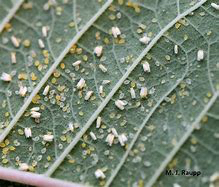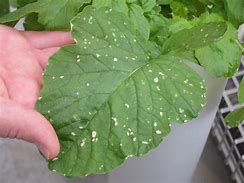Although whiteflies and thrips are no more closely related than humans and chipmunks or armadillos, they are combined on this page because the damage they cause to garden vegetable looks about the same.
Also, some of the methods used to control them are the same.
And finally, since you don’t usually see the insect itself, but only the damage it does to plants, it saves you time to just see everything combined on one page.
You’re welcome.
The Problem
- Both whiteflies and thrips feed on plant sap which they suck from the leaf surfaces.
- This reduces the vigor on the plants and can lead to yellowed, wilted foliage — definitely not edible.
- These insects also carry viruses which infect plants and cause further damage causing areas of die-back on leaves and stems.
Identification
- These are both very small insects.
- Whiteflies have a wingspan of less than 3 mm (just over one-tenth of an inch) and a body length of 1 mm to 2 mm (0.4 to 0.8 inches).
- Most thrips are about 1 mm long.
- If you look closely at an infestation of whiteflies, you can see a lot of small, white, maggot-like creatures across the leaf surface.


Signs of damage
- Like aphids, whiteflies insert their beaks into plants and extract sap.
- To avoid blowing up from the fluid pressure inside the plant, they also let most of the sap pass through their bodies — only tapping off what they need for nutrition.
- What passes through undigested leaves a sticky residue on plant leaves.
- This eventually supports a colony of fungus which can show up as a black coating on the leaf.
- Whitefly infestations begin, and are more dense, on the underside of leaves so check those frequently and don’t wait for them to appear on the upper surface.
Thrips have a more primitive mouth than whiteflies. They makes cuts in the plant’s outer tissue. This results in a number of patches of dead tissue on the surface.

Controls
- Surprisingly enough, controlling whiteflies begins with fertilizer.
- Over-fertilizing, especially with nitrogen, makes your plants much more attractive to whiteflies.
- Yellow sticky traps can help both in monitoring for adult populations and suppressing them.
- A strong stream of water from a garden hose will reduce pest populations.
- Ladybugs and lacewings feed on eggs of these plant predators.
- Spraying infested foliage with either a botanical soap or with Neem oil will reduce heavy infestations.
